Introduction
The Project Management Office (PMO) has traditionally been viewed as a regulatory and compliance function within organizations. However, as project complexity grows and strategic ambitions increase, the role of the PMO in project base businesses must evolve.
This article explores the transformation of the PMO from a compliance-focused entity to a strategic enabler, highlighting its potential to drive efficiency, integration, and business alignment.
The Traditional View of PMOs – And Why It Needs to Evolve
For many organizations, the Project Management Office (PMO) is still seen as a regulatory and compliance function. It’s often introduced in response to project failures, delays, overruns, inconsistent reporting and tasked with implementing procedures, templates, and control gates. In such environments, executives and project teams may see the PMO as an administrative layer, not a strategic partner. The result? A missed opportunity.
The truth is: the PMO should not exist only to control—it should exist to enable delivery, support decision-making, and align with business strategy.
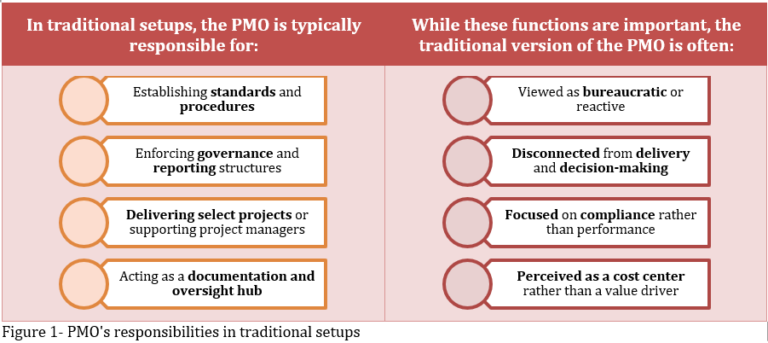
Does Your Organization Really Need a PMO—and What Kind?
Not every organization starts with a PMO. But when project complexity grows, performance issues persist, or strategic ambitions increase, the absence of a structured project management environment becomes too costly to ignore. Let’s go back to basics:
a. How to know it's time to establish or reshape your PMO?
We have often seen clients reach the tipping point when:
- They lose money or face reputational risks on multiple projects
- Clients’ satisfaction declines
- Project teams working in silos
- Every project manager works differently and there’s no standard to evaluate performance
- KPIs, templates, and approvals inconsistent
- They are losing institutional knowledge between projects
- They struggle to collect reliable, portfolio-wide data
- The number, scale, or complexity of projects increases
- They expand into new geographies or market sectors
- They are preparing for strategic growth or acquisition
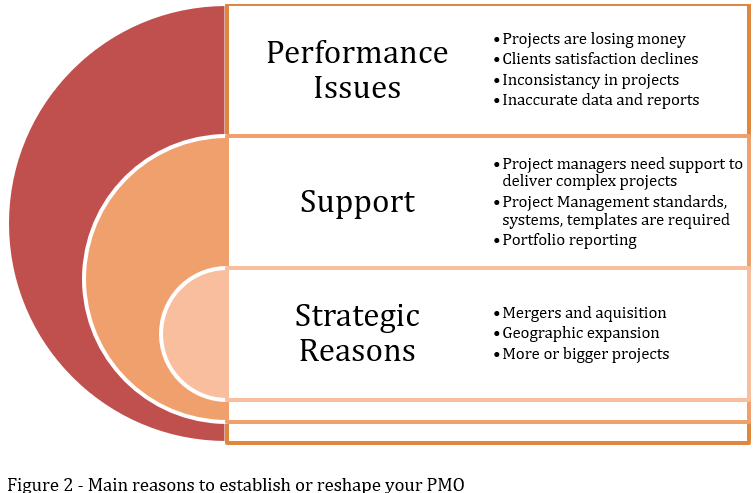
b. What Kind of PMO Do You Need?
PMOs are not one-size-fits-all. They should be shaped by your strategic goals, organizational culture, and project landscape. Common PMO types include:

Choosing the right model depends on your needs, gaps, and growth trajectory. You may decide to focus on one type or combine several ones in your organization.
c. Assess Your Projects and Organizational Maturity
The PMO’s structure and responsibilities should evolve with your organization’s maturity level:
Initial Phase: Minimal PM knowledge, fragmented processes. PMO is reactive, often project-specific or temporary, and mostly directive. Formed to fix project issues.
Developing/Defined Phase: Increased understanding and consistency. PMO expands its support role, gets involved in tool selection and training, and begins tracking value.
Center of Excellence (COE): PMO becomes strategic, enterprise-level, and fully integrated. It partners with the business, drives continuous improvement, and supports portfolio governance.
A well-designed PMO is not just a reaction to problems, it’s a foundation for growth, predictability, and strategic readiness.
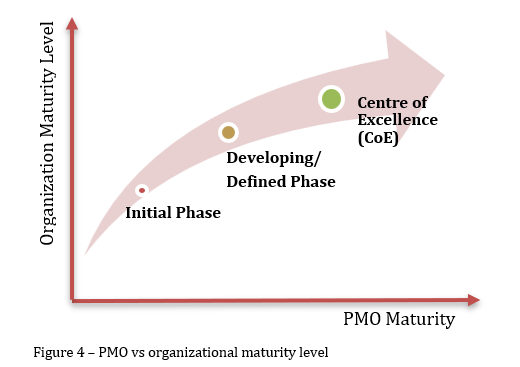
The Evolving Roles of a Mature PMO as a Center of Excellence
In the following sections, we will evaluate the various critical roles that a mature PMO, functioning as a Center of Excellence, can undertake.
a. The PMO as an Interdisciplinary Coordinator and Integrator
We have all seen the following shortfalls in our organizations:
- A company that delivers EPC/EPCM projects has five different Project Change Management procedures, guidelines and templates—each issued by different functions: PMO, project controls, procurement, commercial, and construction. They contradict each other and confuse project teams.
- An engineering consulting firm which has only one mission in its projects, design, mandates creation of both a Project Execution Plan (by PMO) and a Design Management Plan (by Engineering Management Committee), with duplicated content, inconsistent terminology, and contradicting guidlines.
- In one large organization, the PMIS system was configured by IT with its own logic, governance layers, and training, completely disconnected from project procedures and actual delivery workflows because of unrealistic assumptions and software limitations.
- Training programs are developed in silos: each department runs its own sessions, with no coordination or common language.
These are not unusual cases. They’re symptoms of a deeper issue: lack of integration and cross-functional coordination, a gap the PMO should fill.


The PMO’s integration role includes:
- Aligning project teams/activities with business strategies and goals
- Interdisciplinary/inter-functional coordination and reviews of their procedures, approvals, training, and systems
- Enhancing performance and efficiency by enabling clarity, reducing rework, eliminating duplications/discrepancies and blind spots.
- Aligning project systems, procedures, and people
- Aligning project delivery framework with real-world project delivery practices, and clients’ needs (templates, guidelines, workflows, governance models, training and systems)
Integration is not a buzzword. It’s a survival strategy in complex, multi-stakeholder environments. A siloed organization may deliver projects—but not predictably, not efficiently, and not without waste. A modern PMO doesn’t just create procedures. It connects functions, aligns expectations, and makes project execution easier, not harder.
b. The PMO as an Efficiency and Productivity Enabler
When projects go off track, most teams talk about scope, budget, and schedule. But underneath it all is a quieter problem: inefficiency. Inefficiency shows up as duplicated efforts, unclear roles, low accountability, poor handovers, and misaligned systems. And productivity? It suffers quietly until it’s too late.
This is where a mature PMO proves its real value, not just in governance, but in building the foundation for efficiency and sustained performance.
First, a quick reminder: what are definitions of efficiency and productivity?

In project terms, it means delivering the desired outcomes with minimal waste of time, cost, resources, and energy. But in engineering and construction projects, efficiency has many moving parts:
- Design iterations caused by vague requirements
- Construction rework due to poor planning or quality
- Delays in procurement due to poor scope alignment
- Cost/schedule disconnects
- Scheduling disconnects at interfaces such as engineering and site work
- Conflicting or duplicative procedures between different departments
- Fragmented reporting across systems
- Fragmented communication between engineering, controls, construction, and finance
- Misaligned training and onboarding processes
Overlapping approvals
These are not just operational hiccups, they’re systemic gaps. And they bleed money, time, and team morale. The PMO’s Role in Driving Efficiency.

A well-positioned PMO is a performance enabler.
Not just delivering reports, but building the structure, tools, and behaviors that allow teams to deliver more value with less waste.
This is where the PMO steps in
An effective PMO doesn’t just track progress, it helps create the conditions for projects to run efficiently. A strategic PMO applies systems thinking to identify and eliminate the root causes of inefficiency. It can:
- Establish and maintain clear processes, with defined handovers and roles
- Identify and remove duplicated procedures and contradictory requirements
- Align planning, engineering, procurement, and construction schedules
- Integrate cost, schedule, and resource planning tools
- Standardize reporting, training, and decision-making across teams
- Surface early warnings by interpreting project data. Identify “bleeding areas” across multiple projects through data
- Support optimization initiatives, such as Lean methods or Agile planning
- Benchmark productivity trends across projects and functions through coaching, onboarding, and lessons learned
It’s not about adding layers of control. It’s about removing noise, confusion, and friction. So, the team can focus on delivery.
c. The PMO as a Technology Enabler in Project-Based Businesses
Many project-based businesses invest heavily in technology; ERPs, HR, financial and CRM systems, PMIS and control platforms, design, procurement, and construction intelligence tools and many others…Who selects them? In many cases, IT and Digital teams with input from associated departments.
The reality is without PMO’s active involvement in this process, those systems often fail to deliver what the project teams, and as the end-result the business need. Here’s what we’ve all seen more than once:
- Project teams are bypassing the corporate systems and procedures, using side tools, and even are manipulating data and reports to make sense of them.
- Cost and revenue tracking data in PMIS doesn’t match with the data in financial system.
- PMIS platforms: full of features, but none tailored to actual delivery workflows.
- Data stored in silos and teams are using multiple platforms. Therefore, despite increasing technology utilization in our businesses and projects, our efficiency is declining.
- Automation exists but adds friction because it’s built on top of misaligned processes.
- Leaders and Managers don’t have access to accurate data for decision making, or dealing with the risk raised due to inappropriate approvals.
These problems don’t happen because people aren’t trying. Rather because the PMO wasn’t actively involved to promote systems thinking and create integrated work and dataflows as per projects and the business needs.
The PMO’s Role as a Technology Enabler
A modern PMO is uniquely positioned to bridge technology and delivery. It understands project needs and workflows, governance, stakeholder needs, and pain points, in addition to the business needs and can translate those into system requirements that help, not hinder, the project and support teams as well as executives and the decision makers.
Here’s how a PMO adds value:
- Identifies opportunities for automation of repetitive tasks and approvals
- Guides the design and configuration of systems to reflect delivery workflows
- Facilitates interdisciplinary system integration
- Aligns systems with governance, procedures, and trainings
- Ensures data is captured once and used many times
- Supports real-time dashboards for informed decision-making
- Prevents development of isolated systems that create fragmented data environments


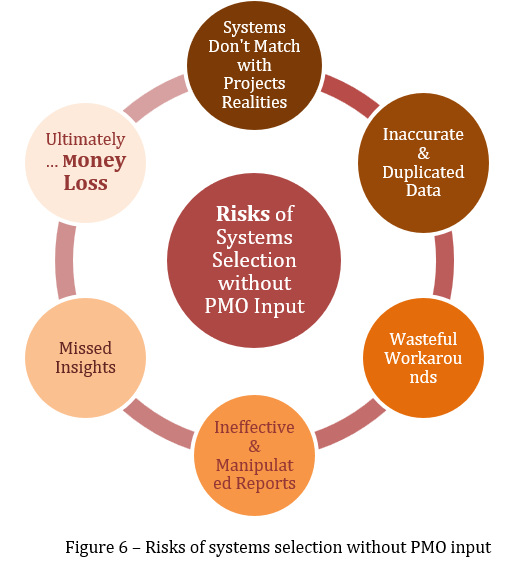
The Hidden Risks
When technology decisions are made without PMO input, the consequences aren’t just frustration, they’re financial. Systems that don’t match project realities lead to missed insights, duplicated data entry efforts and inaccurate information, wasteful workarounds, ineffective and in some cases manipulated reporting, missed insight, and ultimately… money loss.
The PMO doesn’t need to be the developer—but it must be the translator between business, project delivery, and IT. A well-positioned PMO makes technology work for the project—not the other way around. It ensures that systems drive productivity, accuracy, and insight—not just compliance.
d. The Business-Oriented PMO and a Strategic Partner
We’ve all watched PMOs become trapped in a narrow corner of the business, creating guidelines, managing workflows, enforcing systems and templates, issuing dashboards, chasing updates—not influencing key decisions or driving business performance.
And yet, in every project-based business I’ve worked with, there’s a clear need for a function that connects strategy to execution, ambition to capacity, and investment to risk. That’s where a modern PMO should sit—not on the sidelines, but in the core and as a partner.
A Two-Way Relationship with Leadership
The PMO–leadership relationship must be bidirectional:
- On one hand, the PMO enables strategic implementation, translating goals into executable portfolios, aligning priorities, and building delivery readiness.
- On the other hand, it advises leadership, provides grounded insights based on real-time data, team capacity, delivery risks, and lessons from past and current performance.
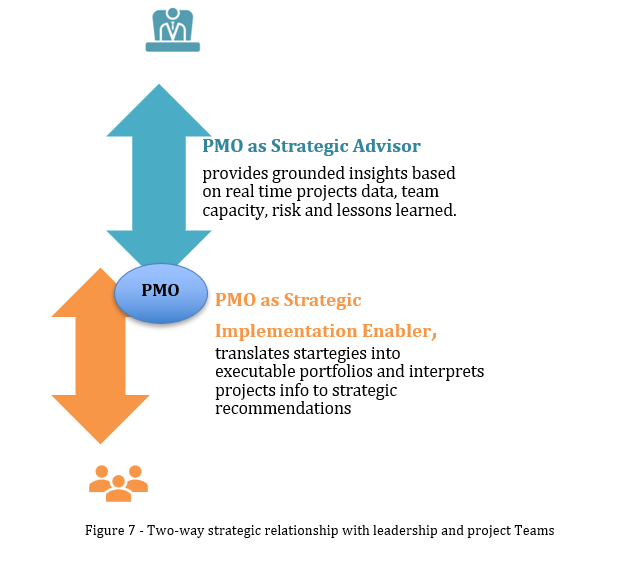
A strategic PMO in action:
- Aligns delivery with strategic priorities
- Supports executive planning and trade-off analysis
- Shapes project pipelines and investment decisions
- Tracks performance against business outcomes
- Advises leadership, not just project teams
- The PMO supports leadership in M&A integration, transformation initiatives, and major capital programs—speaking the language of business, not just projects.
Real Life Example: Strategic Growth Through Acquisition
A company may select acquisition as their growth strategy (entering a new market by acquiring expertise they previously lacked or entering a new geographical market). What seemed simple revealed deep gaps in culture, procedures and tools, approvals, and delivery logic. The PMO stepped in to:
- Provide input for merging strategy and implementation plans
- Align procedures and workflows across both entities
- Bridge toolsets and governance structures
- Design onboarding and training for both legacy and new teams
- Flag integration risks early, before they escalated into delivery failures
This wasn’t just project support—it was strategic enablement.
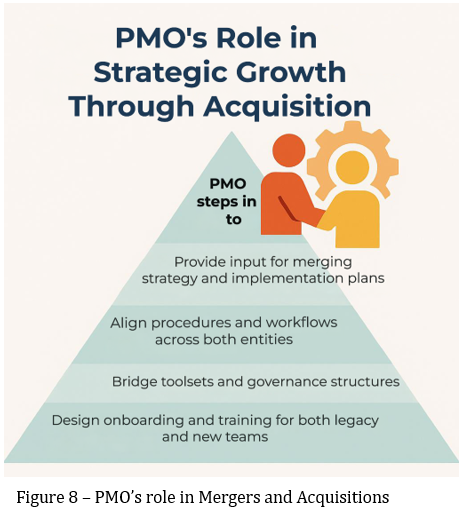
Conclusion
The evolution of the PMO from a compliance-focused entity to a strategic enabler is essential for organizations to thrive in complex, multi-stakeholder environments. By integrating functions, driving efficiency, enabling technology, and aligning with business strategy, the modern PMO becomes a critical partner in performance and growth. Organizations must recognize the value of a well-positioned PMO and leverage its potential to achieve strategic readiness and sustained success.
In conclusion, the PMO’s transformation is not just about changing its role but also about changing the perception of its value within the organization. By demonstrating its ability to drive strategic outcomes, the PMO can gain the trust and support of senior leadership and become an indispensable part of the organization’s success.
Do you have any questions?
Click and book a 60 minutes free consultation meeting today.
